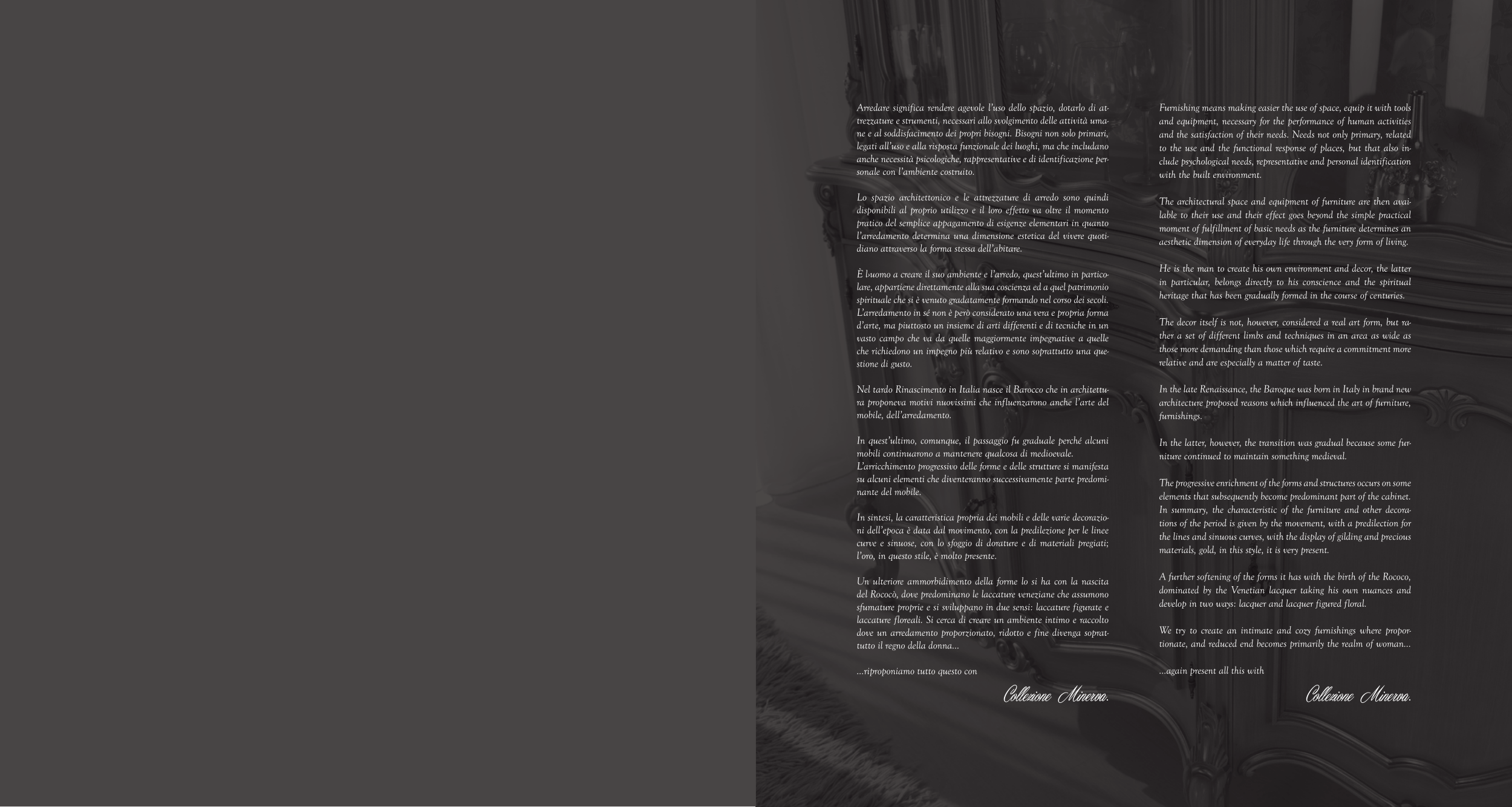Furnishing means making easier the use of space, equip it with tools
and equipment, necessary for the performance of human activities
and the satisfaction of their needs. Needs not only primary, related
to the use and the functional response of places, but that also in-
clude psychological needs, representative and personal identification
with the built environment.
The architectural space and equipment of furniture are then avai-
lable to their use and their effect goes beyond the simple practical
moment of fulfillment of basic needs as the furniture determines an
aesthetic dimension of everyday life through the very form of living.
He is the man to create his own environment and decor, the latter
in particular, belongs directly to his conscience and the spiritual
heritage that has been gradually formed in the course of centuries.
The decor itself is not, however, considered a real art form, but ra-
ther a set of different limbs and techniques in an area as wide as
those more demanding than those which require a commitment more
relative and are especially a matter of taste.
In the late Renaissance, the Baroque was born in Italy in brand new
architecture proposed reasons which influenced the art of furniture,
furnishings.
In the latter, however, the transition was gradual because some fur-
niture continued to maintain something medieval.
The progressive enrichment of the forms and structures occurs on some
elements that subsequently become predominant part of the cabinet.
In summary, the characteristic of the furniture and other decora-
tions of the period is given by the movement, with a predilection for
the lines and sinuous curves, with the display of gilding and precious
materials, gold, in this style, it is very present.
A further softening of the forms it has with the birth of the Rococo,
dominated by the Venetian lacquer taking his own nuances and
develop in two ways: lacquer and lacquer figured floral.
We try to create an intimate and cozy furnishings where propor-
tionate, and reduced end becomes primarily the realm of woman...
...again present all this with
Collezione Minerva.
Arredare significa rendere agevole l’uso dello spazio, dotarlo di at-
trezzature e strumenti, necessari allo svolgimento delle attività uma-
ne e al soddisfacimento dei propri bisogni. Bisogni non solo primari,
legati all’uso e alla risposta funzionale dei luoghi, ma che includano
anche necessità psicologiche, rappresentative e di identificazione per-
sonale con l’ambiente costruito.
Lo spazio architettonico e le attrezzature di arredo sono quindi
disponibili al proprio utilizzo e il loro effetto va oltre il momento
pratico del semplice appagamento di esigenze elementari in quanto
l’arredamento determina una dimensione estetica del vivere quoti-
diano attraverso la forma stessa dell’abitare.
È l›uomo a creare il suo ambiente e l’arredo, quest’ultimo in partico-
lare, appartiene direttamente alla sua coscienza ed a quel patrimonio
spirituale che si è venuto gradatamente formando nel corso dei secoli.
L’arredamento in sé non è però considerato una vera e propria forma
d’arte, ma piuttosto un insieme di arti differenti e di tecniche in un
vasto campo che va da quelle maggiormente impegnative a quelle
che richiedono un impegno più relativo e sono soprattutto una que-
stione di gusto.
Nel tardo Rinascimento in Italia nasce il Barocco che in architettu-
ra proponeva motivi nuovissimi che influenzarono anche l’arte del
mobile, dell’arredamento.
In quest’ultimo, comunque, il passaggio fu graduale perché alcuni
mobili continuarono a mantenere qualcosa di medioevale.
L’arricchimento progressivo delle forme e delle strutture si manifesta
su alcuni elementi che diventeranno successivamente parte predomi-
nante del mobile.
In sintesi, la caratteristica propria dei mobili e delle varie decorazio-
ni dell’epoca è data dal movimento, con la predilezione per le linee
curve e sinuose, con lo sfoggio di dorature e di materiali pregiati;
l’oro, in questo stile, è molto presente.
Un ulteriore ammorbidimento della forme lo si ha con la nascita
del Rococò, dove predominano le laccature veneziane che assumono
sfumature proprie e si sviluppano in due sensi: laccature figurate e
laccature floreali. Si cerca di creare un ambiente intimo e raccolto
dove un arredamento proporzionato, ridotto e fine divenga soprat-
tutto il regno della donna…
…riproponiamo tutto questo con
Collezione Minerva.


